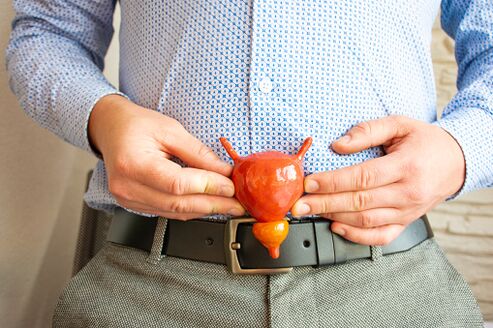Prostatitis is a typical disease of men, which is accompanied by dysfunction of the urogenital system and contributes to the development of many irreversible pathologies.The disease is inflammation of the prostate.

Symptoms of the disease are as follows:
- pain in almost all parts of the hip area (perineum, anus, groin, scrotum, etc.);
- urination becomes more frequent, accompanied by pain;
- the body temperature rises, and the temperature of the anus is noticeably higher than the temperature of the armpit;
- joint and muscle pain may vary in severity;
- A severe headache occurs periodically, and a general weakness of the body appears.
Why does prostatitis occur?
The causes of the pathology are infectious and non-infectious.It is clear that in the first case, the cause of the disease is the activity of microorganisms that enter the man's body from the outside.
Among the non-infectious causes, it is worth highlighting weakened immunity, hypothermia, low physical activity, prolonged sexual abstinence, excessively active sex and alcoholism.
Infectious causes of prostatitis can be divided into two types.The first type of infectious causes includes sexually acquired infections from an infected partner, and the second type includes infectious diseases existing in men's bodies, the background of which is prostatitis (chronic tonsillitis, sinusitis, kidney disease).
Types of prostatitis
Due to many factors and criteria, prostatitis is acute, chronic, chronic bacterial and asymptomatic.The disease is often accompanied by urethritis or vesiculitis.The occurrence of acute prostatitis can be caused by the pathogenic activity of a large number of microorganisms (Escherichia coli, Klebsiella, Proteus, Pseudomonas aeruginosa, Enterobacter, Staphylococcus aureus, etc.).Many microorganisms are an integral part of the healthy microflora of skin tissues or intestines, but when they get into the prostate tissue, they cause a rapidly developing inflammatory process.Due to the pronounced clinical symptoms, diagnosing the acute form of the pathology is a relatively simple task.Blood and urine tests are usually sufficient, but in order to provide maximum information, smears can also be prepared for bacteriological examination, transrectal ultrasound, computed tomography or magnetic resonance imaging.
The development of the chronic bacterial form of prostatitis occurs as a result of the pathogenic activity of pathogenic microorganisms that have entered the prostate tissue.Among the methods for diagnosing this form of the disease, it is worth highlighting uroflowmetry, microscopic examination of prostate secretions, and survey urography.
Treatment of prostatitis
The treatment of prostatitis is based on the use of antibiotics, with variable aggressiveness depending on the development and course of the pathology.The prescription of medicines is unique in each case, depending on the form of the disease and the characteristics of the body.The prescription and dosage of the drugs is determined by the treating urologist based on the results of the diagnostic tests.For some forms of prostatitis, combined therapy is used, i.e. the simultaneous use of several antibiotics;therefore, they prescribe drugs that neutralize their side effects (probiotics).It is possible to use immunostimulants to strengthen the functional capacity of the immune system and vitamin complexes.In some cases, prostate massage is prescribed.The treatment of the disease must be approached very, very seriously, at least because of the malignant tumors that may develop during the development of prostatitis.Prostate cancer is not only a dangerous disease, but also often threatens a person's life.Do not neglect treatment under any circumstances, and when the first signs of the disease appear, consult a urologist.Therapy in the early stages of prostatitis helps to get rid of the disease forever.
































